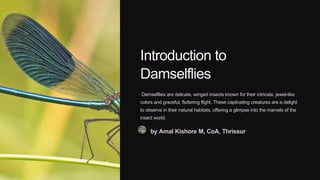Introduction to the reprodutive biology of damsel fly and its mechanism
•Télécharger en tant que PPTX, PDF•
0 j'aime•7 vues
introduction to reproductive biology of damsel fly and its mechanism
Signaler
Partager
Signaler
Partager

Recommandé
Contenu connexe
Similaire à Introduction to the reprodutive biology of damsel fly and its mechanism
Similaire à Introduction to the reprodutive biology of damsel fly and its mechanism (20)
Classification of Animals-Seanna Sofiah Santillan.ppt

Classification of Animals-Seanna Sofiah Santillan.ppt
Echinoderms are the only invertebrate group of deuterostomes.pdf

Echinoderms are the only invertebrate group of deuterostomes.pdf
Dernier
Dernier (20)
Biochemistry and Biomolecules - Science - 9th Grade by Slidesgo.pptx

Biochemistry and Biomolecules - Science - 9th Grade by Slidesgo.pptx
Mining Activity and Investment Opportunity in Myanmar.pptx

Mining Activity and Investment Opportunity in Myanmar.pptx
Emergent ribozyme behaviors in oxychlorine brines indicate a unique niche for...

Emergent ribozyme behaviors in oxychlorine brines indicate a unique niche for...
Climate extremes likely to drive land mammal extinction during next supercont...

Climate extremes likely to drive land mammal extinction during next supercont...
GBSN - Microbiology (Unit 7) Microbiology in Everyday Life

GBSN - Microbiology (Unit 7) Microbiology in Everyday Life
Jet reorientation in central galaxies of clusters and groups: insights from V...

Jet reorientation in central galaxies of clusters and groups: insights from V...
Extensive Pollution of Uranus and Neptune’s Atmospheres by Upsweep of Icy Mat...

Extensive Pollution of Uranus and Neptune’s Atmospheres by Upsweep of Icy Mat...
In-pond Race way systems for Aquaculture (IPRS).pptx

In-pond Race way systems for Aquaculture (IPRS).pptx
Isolation of AMF by wet sieving and decantation method pptx

Isolation of AMF by wet sieving and decantation method pptx
WASP-69b’s Escaping Envelope Is Confined to a Tail Extending at Least 7 Rp

WASP-69b’s Escaping Envelope Is Confined to a Tail Extending at Least 7 Rp
NuGOweek 2024 full programme - hosted by Ghent University

NuGOweek 2024 full programme - hosted by Ghent University
Plasmapheresis - Dr. E. Muralinath - Kalyan . C.pptx

Plasmapheresis - Dr. E. Muralinath - Kalyan . C.pptx
Continuum emission from within the plunging region of black hole discs

Continuum emission from within the plunging region of black hole discs
Soil and Water Conservation Engineering (SWCE) is a specialized field of stud...

Soil and Water Conservation Engineering (SWCE) is a specialized field of stud...
Introduction to the reprodutive biology of damsel fly and its mechanism
- 1. Introduction to Damselflies Damselflies are delicate, winged insects known for their intricate, jewel-like colors and graceful, fluttering flight. These captivating creatures are a delight to observe in their natural habitats, offering a glimpse into the marvels of the insect world. by Amal Kishore M, CoA, Thrissur
- 2. Anatomy and Identification Slender Body Damselflies have a long, thin abdomen that helps them maneuver swiftly through the air. Delicate Wings Their wings are narrow and translucent, propelling them with a distinctive, fluttering motion. Vibrant Colors Damselflies come in a stunning array of colors, including blues, greens, reds, and metallic hues.
- 3. Habitat and Behavior 1 Freshwater Homes Damselflies thrive near ponds, streams, and other bodies of freshwater, where they can find ample food and breeding grounds. 2 Perching Patterns When at rest, damselflies often hold their wings together vertically, unlike their dragonfly cousins. 3 Agile Flyers Damselflies dart and hover with remarkable precision, making them a joy to observe in flight.
- 4. Mating Rituals 1 Courtship Male damselflies perform intricate aerial displays to attract potential mates, using their vibrant colors and agile movements. 2 Tandem Pair Once a female is receptive, the male will grasp her behind the head, forming a "tandem pair" as they fly together. 3 Egg Fertilization The female then bends her abdomen to receive the male's sperm, completing the mating process.
- 5. Egg Laying and Oviposition Underwater Eggs After mating, the female damselfly deposits her eggs directly into the water, either on aquatic plants or submerged surfaces. Careful Placement The female carefully selects the oviposition site, ensuring her eggs have the best chance of survival and development. Egg Incubation The eggs then undergo a period of incubation, with the nymphs eventually hatching and beginning their aquatic larval stage.
- 6. Nymphal Development Aquatic Nymphs Newly hatched damselfly nymphs live in the water, where they hunt for prey and grow through a series of molts. Gills and Camouflage Nymphs have external gills and are often well-camouflaged, blending in with their aquatic environment. Emergence After several weeks or months, the nymphs will emerge from the water and transform into their adult, winged form.
- 7. Emergence and Maturation Climbing The newly emerged damselfly will climb up a plant or other surface, allowing its wings to fully expand and harden. Drying As the damselfly dries, its body and wings will take on their vibrant, adult coloration. First Flight Once the transformation is complete, the damselfly will take its first flight, embarking on the next stage of its life cycle.
- 8. Conservation and Threats Habitat Loss Damselflies are vulnerable to the destruction and degradation of their freshwater habitats, which are critical for their survival. Pesticides Exposure to pesticides and other pollutants can have detrimental effects on damselfly populations. Climate Change Shifts in temperature and precipitation patterns due to climate change can disrupt the delicate balance of damselfly ecosystems. Conservation Efforts Protecting and restoring wetlands, monitoring populations, and reducing pollution are important steps to conserve damselflies.